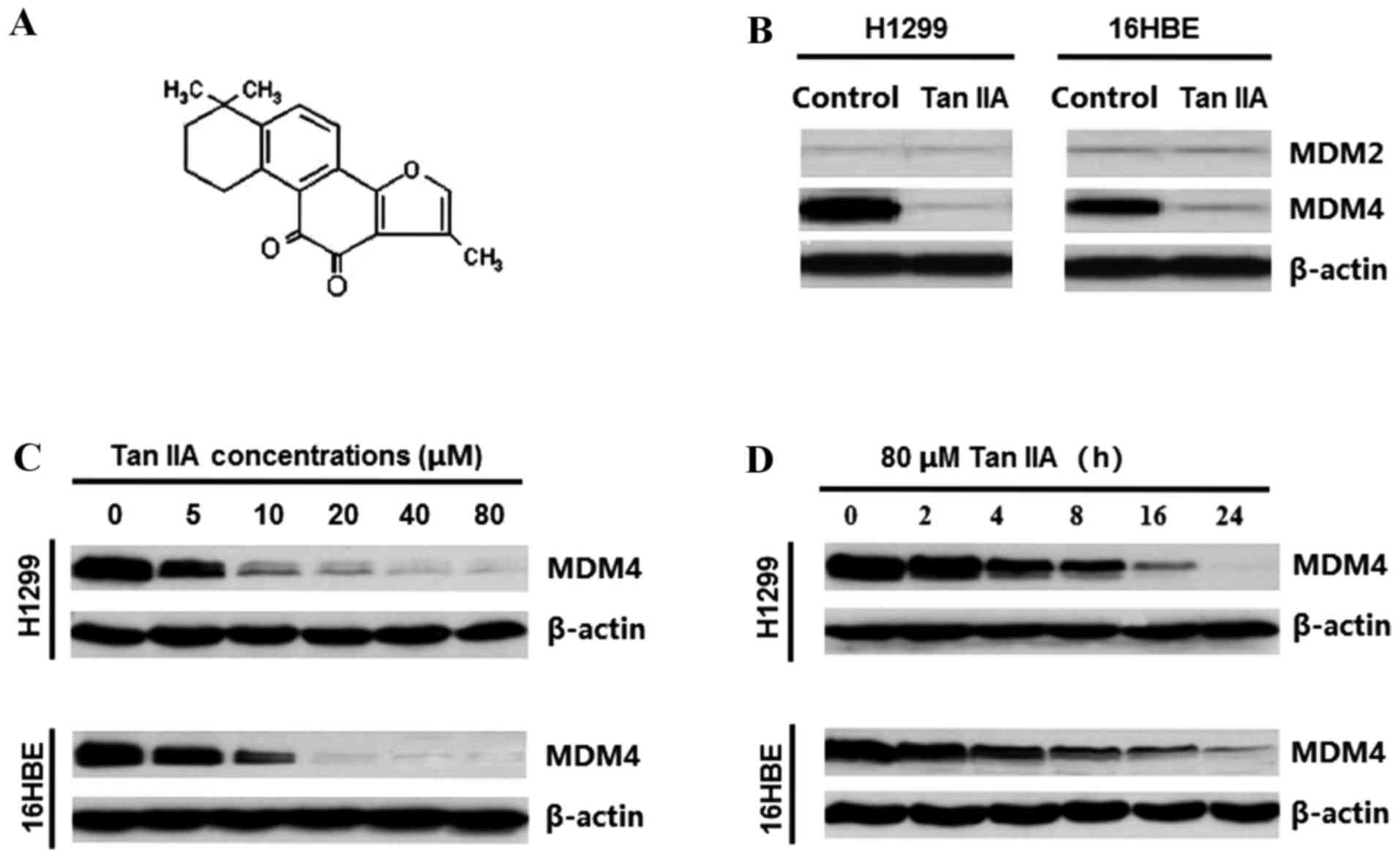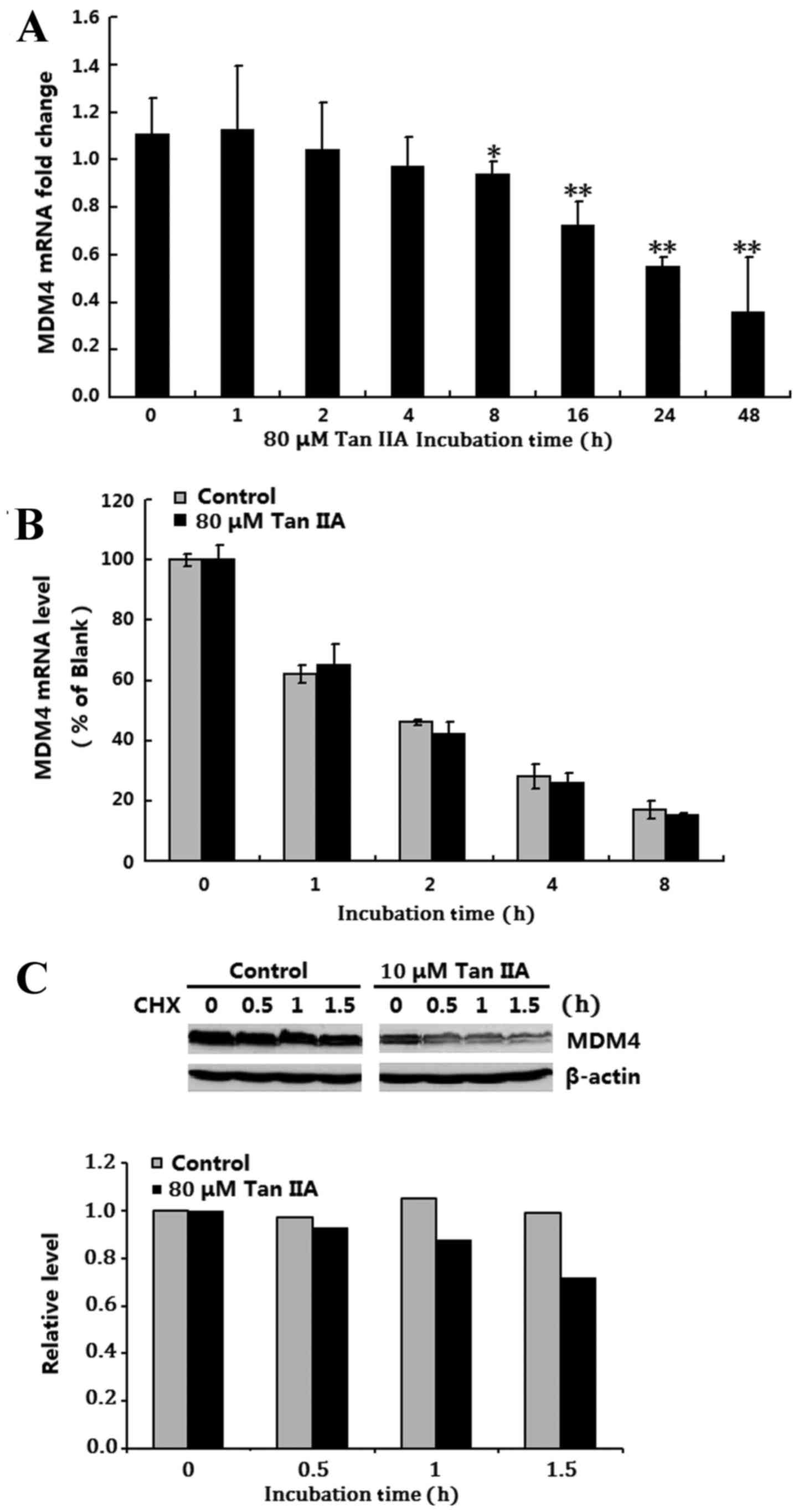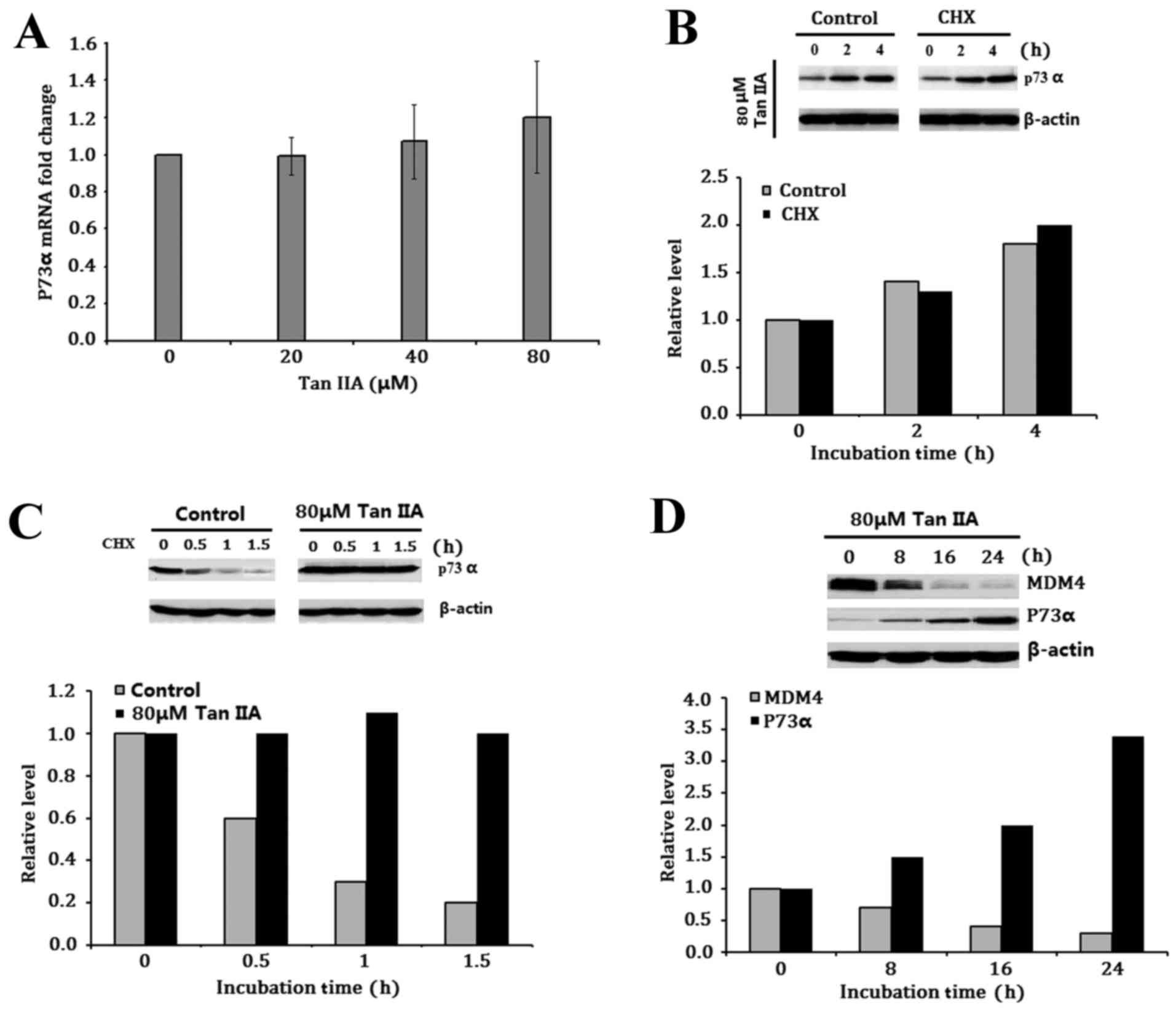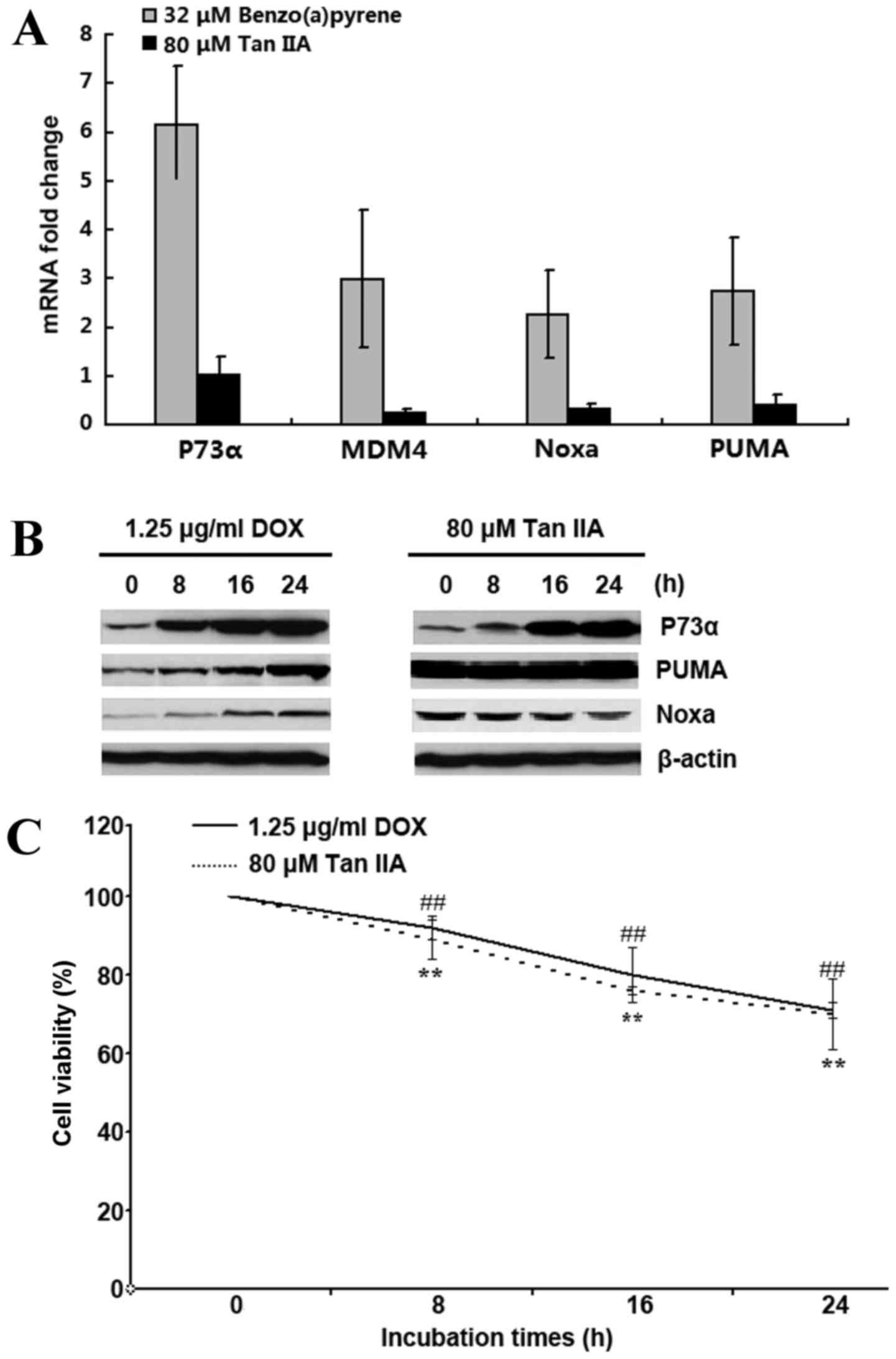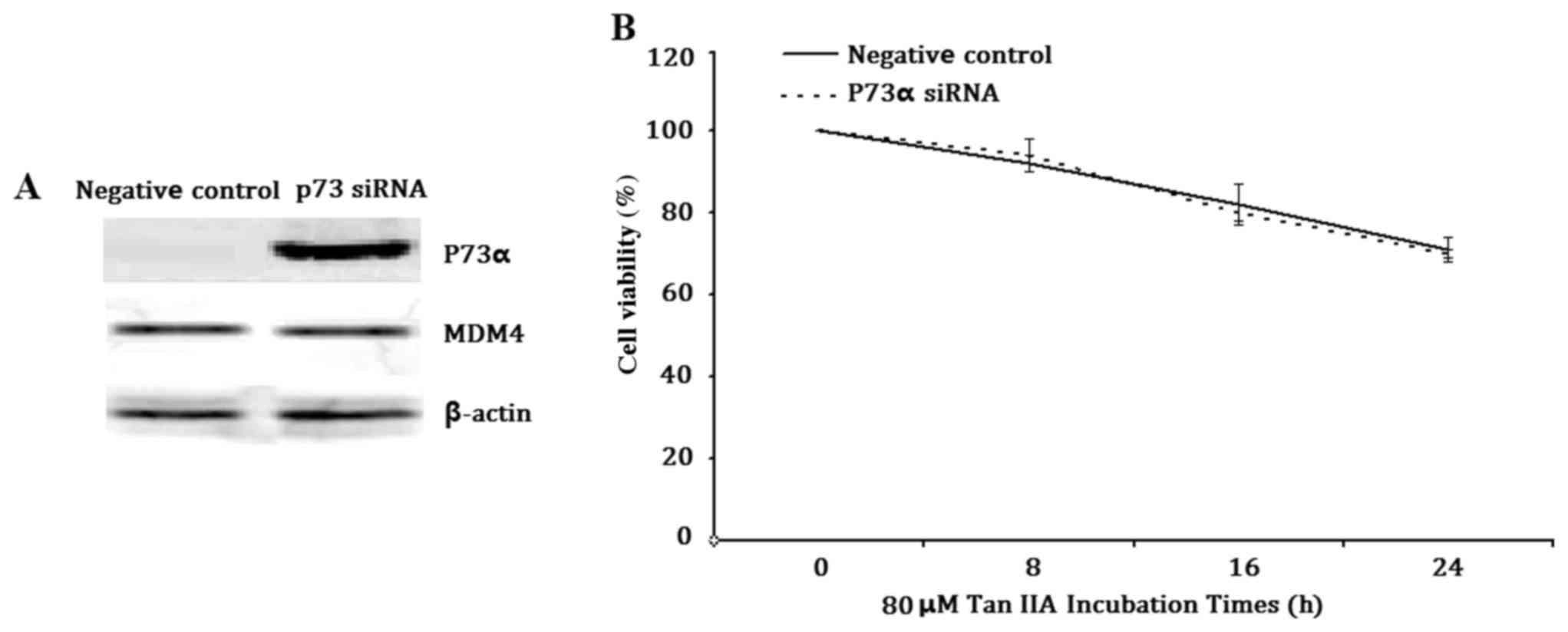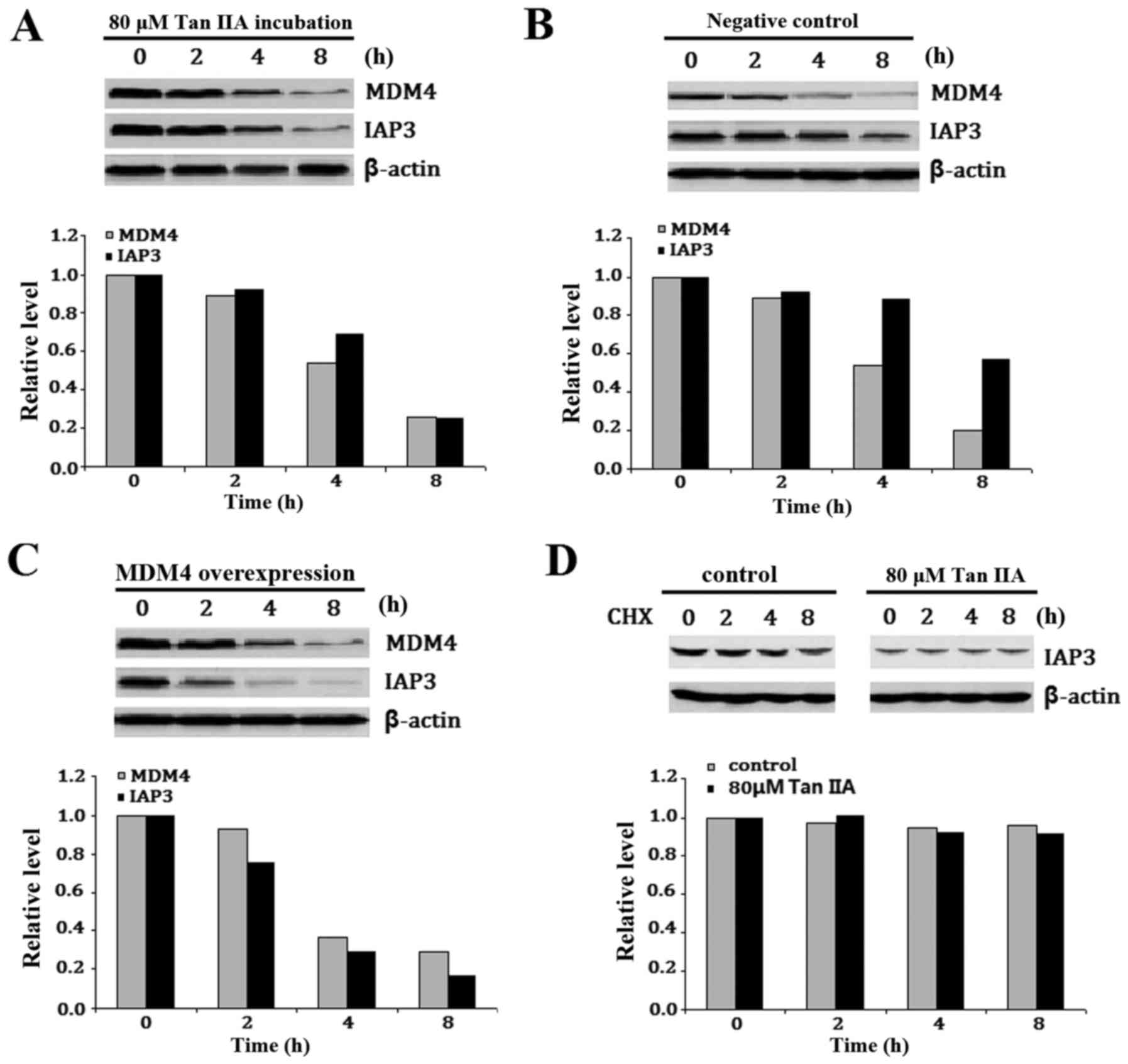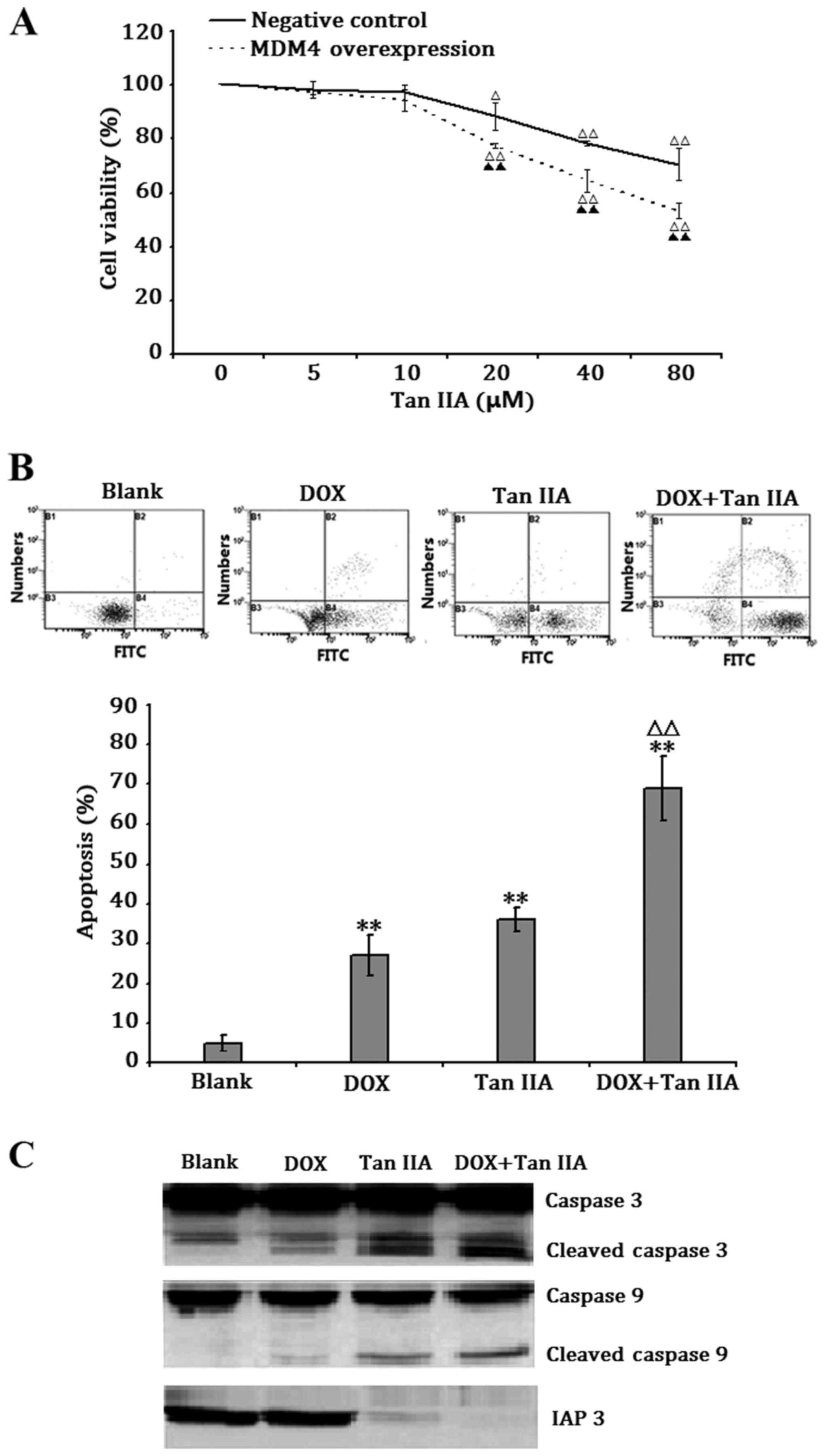|
1
|
Yang W, Ju JH, Jeon MJ, Han X and Shin I:
Danshen (Salvia miltiorrhiza) extract inhibits proliferation of
breast cancer cells via modulation of Akt activity and p27 level.
Phytother Res. 24:198–204. 2010.PubMed/NCBI
|
|
2
|
Franek KJ, Zhou Z, Zhang WD and Chen WY:
In vitro studies of baicalin alone or in combination with Salvia
miltiorrhiza extract as a potential anti-cancer agent. Int J Oncol.
26:217–224. 2005.PubMed/NCBI
|
|
3
|
Munagala R, Aqil F, Jeyabalan J and Gupta
RC: Tanshinone IIA inhibits viral oncogene expression leading to
apoptosis and inhibition of cervical cancer. Cancer Lett.
356:536–546. 2015. View Article : Google Scholar : PubMed/NCBI
|
|
4
|
Wang JF, Feng JG, Han J, Zhang BB and Mao
WM: The molecular mechanisms of Tanshinone IIA on the apoptosis and
arrest of human esophageal carcinoma cells. Biomed Res Int.
2014:5827302014.PubMed/NCBI
|
|
5
|
Hwang SL, Yang JH, Jeong YT, Kim YD, Li X,
Lu Y, Chang YC, Son KH and Chang HW: Tanshinone IIA improves
endoplasmic reticulum stress-induced insulin resistance through
AMP-activated protein kinase. Biochem Biophys Res Commun.
430:1246–1252. 2013. View Article : Google Scholar : PubMed/NCBI
|
|
6
|
Shan YF, Shen X, Xie YK, Chen JC, Shi HQ,
Yu ZP, Song QT, Zhou MT and Zhang QY: Inhibitory effects of
tanshinone II-A on invasion and metastasis of human colon carcinoma
cells. Acta Pharmacol Sin. 11:1537–1542. 2009. View Article : Google Scholar
|
|
7
|
Chiu TL and Su CC: Tanshinone IIA induces
apoptosis in human lung cancer A549 cells through the induction of
reactive oxygen species and decreasing the mitochondrial membrane
potential. Int J Mol Med. 25:231–236. 2010.PubMed/NCBI
|
|
8
|
Reincke S, Govbakh L, Wilhelm B, Jin H,
Bogdanova N, Bremer M, Karstens JH and Dörk T: Mutation analysis of
the MDM4 gene in German breast cancer patients. BMC Cancer.
8:522008. View Article : Google Scholar : PubMed/NCBI
|
|
9
|
Jiang Y, Rao K, Yang G, Chen X, Wang Q,
Liu A, Zheng H and Yuan J: Benzo(a)pyrene induces p73 mRNA
expression and necrosis in human lung adenocarcinoma H1299 cells.
Environ Toxicol. 27:202–210. 2012. View Article : Google Scholar : PubMed/NCBI
|
|
10
|
Alexandrova EM and Moll UM: Role of p53
family members p73 and p63 in human hematological malignancies.
Leuk Lymphoma. 53:2116–2129. 2012. View Article : Google Scholar : PubMed/NCBI
|
|
11
|
Fedorova NE, Emelianova SS, Vinogradskaya
GR, Chichev EV, Murzakova AV, Kirichenko AA, Verbenko VN and Kushch
AA: Effect of Anti-Cancer Drug Doxorubicine on Cytomegalovirus
Infected Human Fibroblasts. Tsitologiia. 57:260–268. 2015.(In
Russian). PubMed/NCBI
|
|
12
|
Zaika AI, Kovalev S, Marchenko ND and Moll
UM: Overexpression of the wild type p73 gene in breast cancer
tissues and cell lines. Cancer Res. 59:3257–3263. 1999.PubMed/NCBI
|
|
13
|
Stiewe T and Putzer BM: p73 in apoptosis.
Apoptosis. 6:447–452. 2001. View Article : Google Scholar : PubMed/NCBI
|
|
14
|
Momand J, Villegas A and Belyi VA: The
evolution of MDM2 family genes. Gene. 486:23–30. 2011. View Article : Google Scholar : PubMed/NCBI
|
|
15
|
Pei D, Zhang Y and Zheng J: Regulation of
p53: A collaboration between Mdm2 and Mdmx. Oncotarget. 3:228–235.
2012. View Article : Google Scholar : PubMed/NCBI
|
|
16
|
Michael D and Oren M: The p53 and Mdm2
families in cancer. Curr Opin Genet Dev. 12:53–59. 2002. View Article : Google Scholar : PubMed/NCBI
|
|
17
|
Zeng X, Chen L, Jost CA, Maya R, Keller D,
Wang X, Kaelin WG Jr, Oren M, Chen J and Lu H: MDM2 suppresses p73
function without promoting p73 degradation. Mol Cell Biol.
19:3257–3266. 1999. View Article : Google Scholar : PubMed/NCBI
|
|
18
|
Katayama A, Ogino T, Bandoh N, Takahara M,
Kishibe K, Nonaka S and Harabuchi Y: Overexpression of small
ubiquitin-related modifier-1 and sumoylated Mdm2 in oral squamous
cell carcinoma: Possible involvement in tumor proliferation and
prognosis. Int J Oncol. 31:517–524. 2007.PubMed/NCBI
|
|
19
|
Laurie NA, Donovan SL, Shih CS, Zhang J,
Mills N, Fuller C, Teunisse A, Lam S, Ramos Y, Mohan A, et al:
Inactivation of the p53 pathway in retinoblastoma. Nature.
444:61–66. 2006. View Article : Google Scholar : PubMed/NCBI
|
|
20
|
Gustafsson B, Axelsson B, Gustafsson B,
Christensson B and Winiarski J: MDM2 and p53 in childhood acute
lymphoblastic leukemia: Higher expression in childhood leukemias
with poor prognosis compared to long-term survivors. Pediatr
Hematol Oncol. 18:497–508. 2001. View Article : Google Scholar : PubMed/NCBI
|
|
21
|
Gustafsson B, Christenson B, Hjalmar V and
Winiarski J: Cellular expression of MDM2 and p53 in childhood
leukemias with poor prognosis. Med Pediatr Oncol. 34:117–124. 2000.
View Article : Google Scholar : PubMed/NCBI
|
|
22
|
Livak KJ and Schmittgen TD: Analysis of
relative gene expression data using real-time quantitative PCR and
2(-Delta Delta C(T)) method. Methods. 25:402–408. 2001. View Article : Google Scholar : PubMed/NCBI
|
|
23
|
Croons V, Martinet W, De Herman AG and
Meyer GR: Differential effect of the protein synthesis inhibitors
puromycin and cycloheximide on vascular smooth muscle cell
viability. J Pharmacol Exp Ther. 325:824–832. 2008. View Article : Google Scholar : PubMed/NCBI
|
|
24
|
Melino G, Bernassola F, Ranalli M, Yee K,
Zong WX, Corazzari M, Knight RA, Green DR, Thompson C and Vousden
KH: p73 Induces apoptosis via PUMA transactivation and Bax
mitochondrial translocation. J Biol Chem. 27:279: 8076–8083.
2004.
|
|
25
|
Grande L, Bretones G, Rosa-Garrido M,
Garrido-Martin EM, Hernandez T, Fraile S, Botella L, de Alava E,
Vidal A, Garcia del Muro X, et al: Transcription factors Sp1 and
p73 control the expression of the proapoptotic protein NOXA in the
response of testicular embryonal carcinoma cells to cisplatin. J
Biol Chem. 287:26495–26505. 2012. View Article : Google Scholar : PubMed/NCBI
|
|
26
|
Gu L, Zhu N, Zhang H, Durden DL, Feng Y
and Zhou M: Regulation of XIAP translation and induction by MDM2
following irradiation. Cancer Cell. 15:363–375. 2009. View Article : Google Scholar : PubMed/NCBI
|
|
27
|
Zhang J, Wang J, Jiang JY, Liu SD, Fu K
and Liu HY: Tanshinone IIA induces cytochrome c-mediated caspase
cascade apoptosis in A549 human lung cancer cells via the JNK
pathway. Int J Oncol. 45:683–690. 2014. View Article : Google Scholar : PubMed/NCBI
|
|
28
|
Chow KU, Nowak D, Boehrer S, Ruthardt M,
Knau A, Hoelzer D, Mitrou PS and Weidmann E: Synergistic effects of
chemotherapeutic drugs in lymphoma cells are associated with
down-regulation of inhibitor of apoptosis proteins (IAPs),
prostate-apoptosis-response-gene 4 (Par-4), death-associated
protein (Daxx) and with enforced caspase activation. Biochem
Pharmacol. 66:711–724. 2003. View Article : Google Scholar : PubMed/NCBI
|
|
29
|
LaCasse EC, Mahoney DJ, Cheung HH,
Plenchette S, Baird S and Korneluk RG: IAP-targeted therapies for
cancer. Oncogene. 27:6252–6275. 2008. View Article : Google Scholar : PubMed/NCBI
|
|
30
|
Eckelman BP, Salvesen GS and Scott FL:
Human inhibitor of apoptosis proteins: Why XIAP is the black sheep
of the family. EMBO Rep. 7:988–994. 2006. View Article : Google Scholar : PubMed/NCBI
|
|
31
|
Wang R, Li B, Wang X, Lin F, Gao P, Cheng
SY and Zhang HZ: Inhibiting XIAP expression by RNAi to inhibit
proliferation and enhance radiosensitivity in laryngeal cancer cell
line. Auris Nasus Larynx. 36:332–339. 2009. View Article : Google Scholar : PubMed/NCBI
|
|
32
|
Qiao L, Li GH, Dai Y, Wang J, Li Z, Zou B,
Gu Q, Ma J, Pang R, Lan HY and Wong BC: Gene expression profile in
colon cancer cells with respect to XIAP expression status. Int J
Colorectal Dis. 24:245–260. 2009. View Article : Google Scholar : PubMed/NCBI
|
|
33
|
Paschall AV, Zimmerman MA, Torres CM, Yang
D, Chen MR, Li X, Bieberich E, Bai A, Bielawski J, Bielawska A and
Liuet K: Ceramide targets xIAP and cIAP1 to sensitize metastatic
colon and breast cancer cells to apoptosis induction to suppress
tumor progression. BMC Cancer. 14:242014. View Article : Google Scholar : PubMed/NCBI
|
|
34
|
Golovine K, Makhov P, Uzzo RG, Kutikov A,
Kaplan DJ, Fox E and Kolenko VM: Cadmium down-regulates expression
of XIAP at the post-transcriptional level in prostate cancer cells
through an NF-kappaB-independent, proteasome-mediated mechanism.
Mol Cancer. 9:1832010. View Article : Google Scholar : PubMed/NCBI
|
|
35
|
Wang L, He G, Zhang P, Wang X, Jiang M and
Yu L: Interplay between MDM2, MDMX, Pirh2 and COP1: The negative
regulators of p53. Mol Biol Rep. 38:229–236. 2011. View Article : Google Scholar : PubMed/NCBI
|
|
36
|
Zhu ZF, Chen LJ, Lu R, Jia J, Liang Y, Xu
Q, Zhou CL, Wang L, Wang S and Yao Z: Tripeptide tyroserleutide
plus doxorubicin: Therapeutic synergy and side effect attenuation.
BMC Cancer. 8:3422008. View Article : Google Scholar : PubMed/NCBI
|
|
37
|
Carvalho C, Santos RX, Cardoso S, Correia
S, Oliveira PJ, Santos MS and Moreira PI: Doxorubicin: The good,
the bad and the ugly effect. Curr Med Chem. 16:3267–3285. 2009.
View Article : Google Scholar : PubMed/NCBI
|
|
38
|
Zeidán Q, Strauss M, Porras N and Anselmi
G: Differential long-term subcellular responses in heart and liver
to adriamycin stress. Exogenous L-carnitine cardiac and hepatic
protection. J Submicrosc Cytol Pathol. 34:315–321. 2002.PubMed/NCBI
|
|
39
|
Wang J, Ma W and Tu P: Synergistically
Improved Anti-tumor Efficacy by Co-delivery Doxorubicin and
Curcumin Polymeric Micelles. Macromol Biosci. 15:1252–1261. 2015.
View Article : Google Scholar : PubMed/NCBI
|



